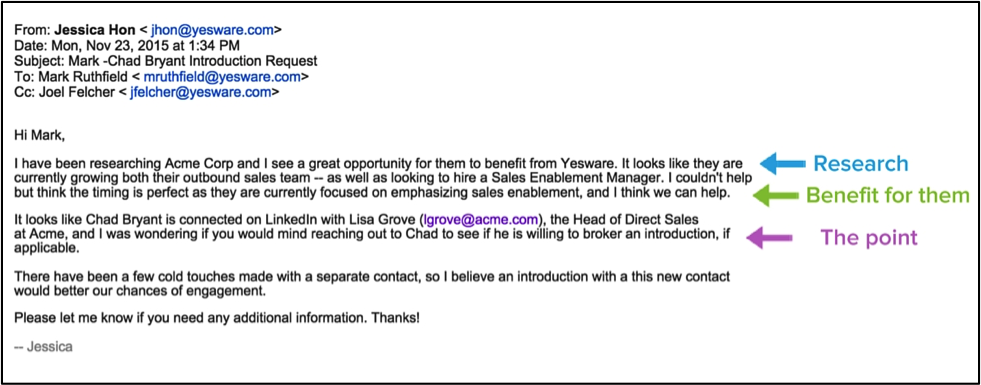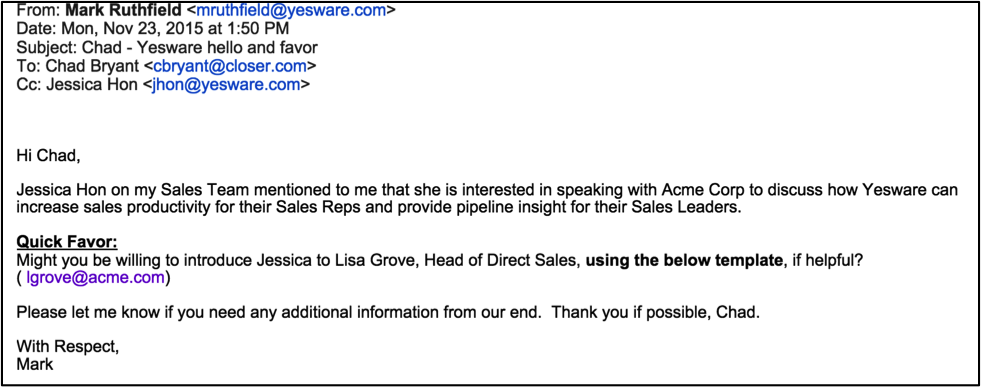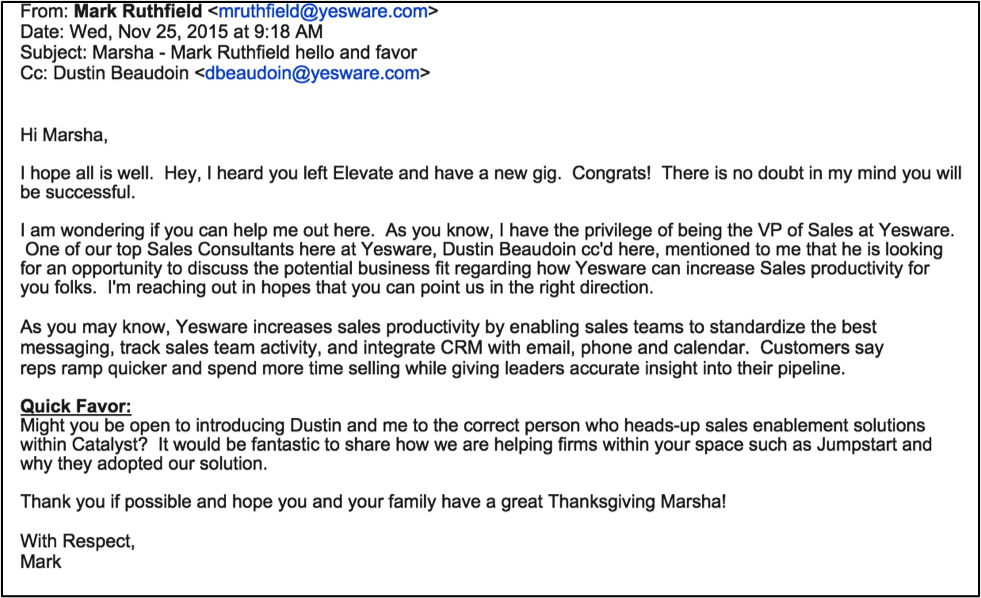How to Write an Introduction Email That Wins You an In
Melissa Williams
How do you convince someone to give you a chance when they’ve never met you? Ask for an introduction email.
Fact: Nine out of 10 people trust recommendations from others they know.
Connecting through a mutual acquaintance can be the difference between a cold email and a warm welcome.
Even better, with the right introduction email template, you save time writing but still show that you put in the extra effort.
Here are four types of introductory emails you can start writing today to land more clients, book more meetings, and grow your career.
Let’s take a look:
- How to Ask for an Email Introduction
- How to Write a Professional Introduction Email
- How to Write an Introduction Email Request to a Client
- How to Get an Inside Referral
- Introduction Email Best Practices
- Common Mistakes to Avoid
- 10 Smart Introduction Email Scenarios
How to Ask for an Email Introduction
A poorly written introduction request reads like a shoddy instruction manual.
The bottom line: It pays to draft an email they can easily forward on your behalf.
The bulk of the content should be written directly to the person you’d like to meet as if they were reading it as-is.
It should include:
- Evidence that you’ve done your research. Seeing this makes people more motivated to help you.
- A clear reason why your target person would benefit from the intro. Satisfying our own self-interests is pretty darn appealing (just how our brains work).
- A succinct message that closes with a clear call to action. Roughly half of email replies are less than 43 words.
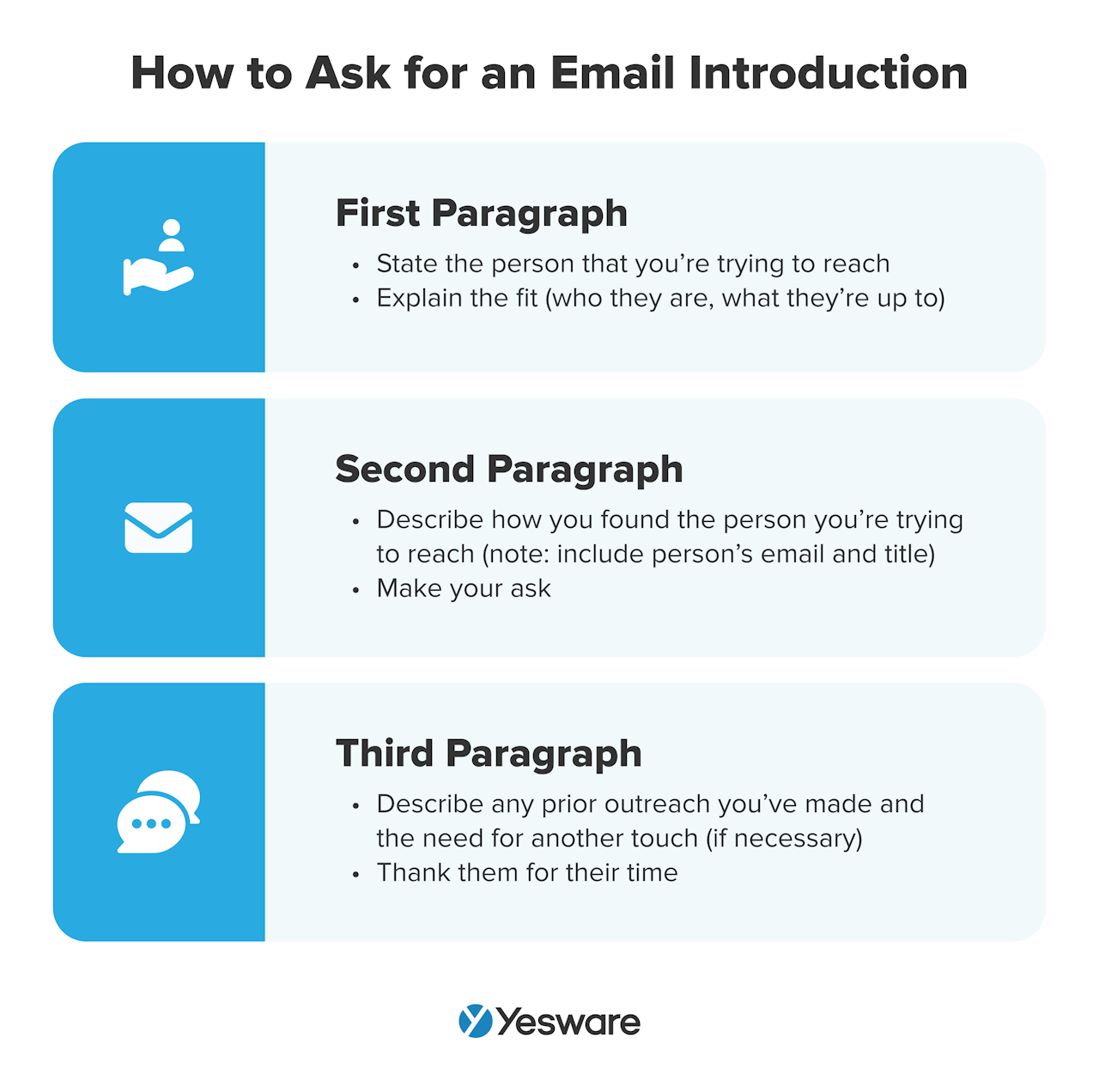 Real-world use case: This email introduction sample is from a Yesware Sales Development Representative who used all three persuasive elements to ask for an introduction (prospect names have been changed):
Real-world use case: This email introduction sample is from a Yesware Sales Development Representative who used all three persuasive elements to ask for an introduction (prospect names have been changed):
With all the boxes checked, she made it super easy for Mark to forward her request to Chad—less than 20 minutes later.
Introduction Email Template
Here’s the email above as a ready-to-use template:
Subject Line: {!First Name} — {!Person you’re trying to reach} Introduction Request
Hi {!First Name},
I’ve been researching {!Company you’re trying to reach} and I see a great opportunity for them to benefit from {!Your Company}. It looks like {!Relevant reason to connect}. I couldn’t help but think the timing is perfect because {!reason}, and I think we can help.
{!How you found the person} ({!Their email address}), {!Title} at {!Company}, and I was wondering if you would mind reaching out to {!Person} to see if they’re willing to broker an introduction, if applicable.
There have been {!prior outreach made}, so I believe an introduction with this new contact would better our chances of engagement.
Please let me know if you need any additional information. Thank you {!Name}!
How to Write a Professional Introduction Email
So, what happens when you receive an introduction request? We recommend using the double-opt-in method to keep it courteous.
Fred Wilson popularized this networking approach as a helpful reminder to be respectful of people’s time. The idea is to ask permission from both parties before green-lighting unsolicited introductions, giving either person a chance to decline if they so choose.
And here’s a step-by-step breakdown of how to write an introduction email using the double opt-in approach:
- First ask the requestor to write you an intro email you can forward along to your contact (if they haven’t already).
- Start with “Hi” or “Hello” to remain professional
- Add a personal note up top — compliments are persuasive, remember?
- Get to the point quickly; you’re asking for a favor
- Put your request in bold font so it directs attention to the action item
- End with a personal note wishing your acquaintance well
Tip: Use email tracking to see which prospects are engaging with your introduction emails and follow up with those most interested.
Real-world use-case: Here’s how our former VP of Sales used this method to let someone opt-in to an email introduction requested by one of our sales reps. It offers clear and compelling reasons why Marsha could benefit from accepting the offer, but only “if possible” and on her terms.
Professional Introduction Email Template
Here’s the introduction email as a template so you can start using it yourself:
Subject Line: {!First Name} — {!Your Name} hello and favor
Hi {!First Name},
I hope all is well. {!Personal note/compliment}.
I am wondering if you can help me out here. {!Briefly introduce person who needs introduction}. {!Person} is looking for an opportunity to discuss the potential business fit regarding how {!Company} can {!benefit}. I’m reaching out in hopes that you can point us in the right direction.
As you may know, {!Additional background information}. Customers say {!social proof}.
Quick Favor:
{!The Ask}. It would be fantastic to share how we are helping customers achive {!results}.Thank you if possible and I hope you {!personal note}.
With Respect,
Tip: Are you sending your emails at the right time? Here’s the best time to send your emails.
How to Write an Introduction Email Request to a Client
Your happy customers are some of the best opportunities for new sales introductions.
Sales teams can leverage their current client base to build new connections and generate lucrative referrals efficiently and with confidence. 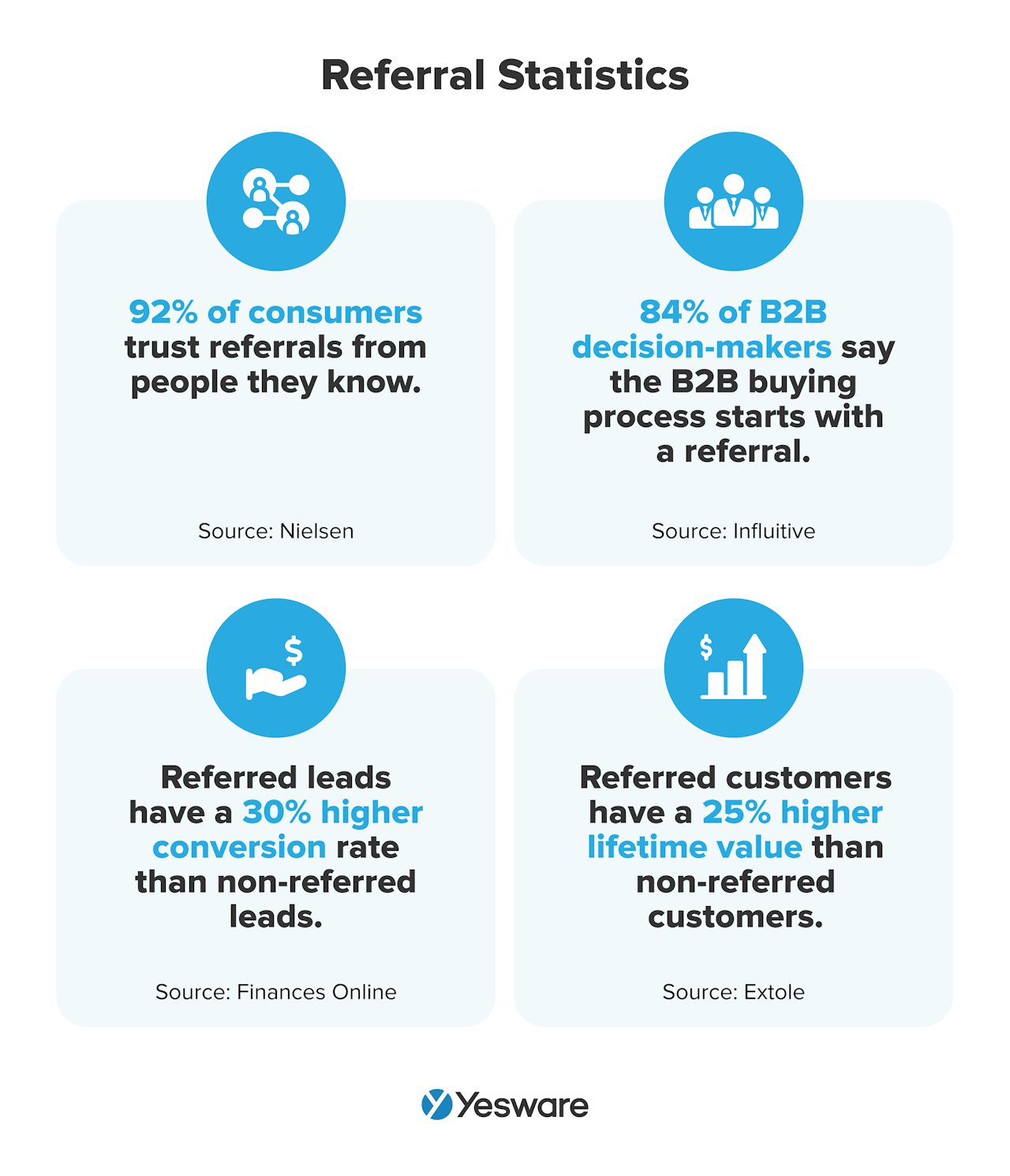 The following email successfully politely and professionally asks a current satisfied customer for an email introduction. It makes a positive first impression, which helps to generate promising sales and referral opportunities.
The following email successfully politely and professionally asks a current satisfied customer for an email introduction. It makes a positive first impression, which helps to generate promising sales and referral opportunities.
Here’s an example of a successful introduction email request to a client:
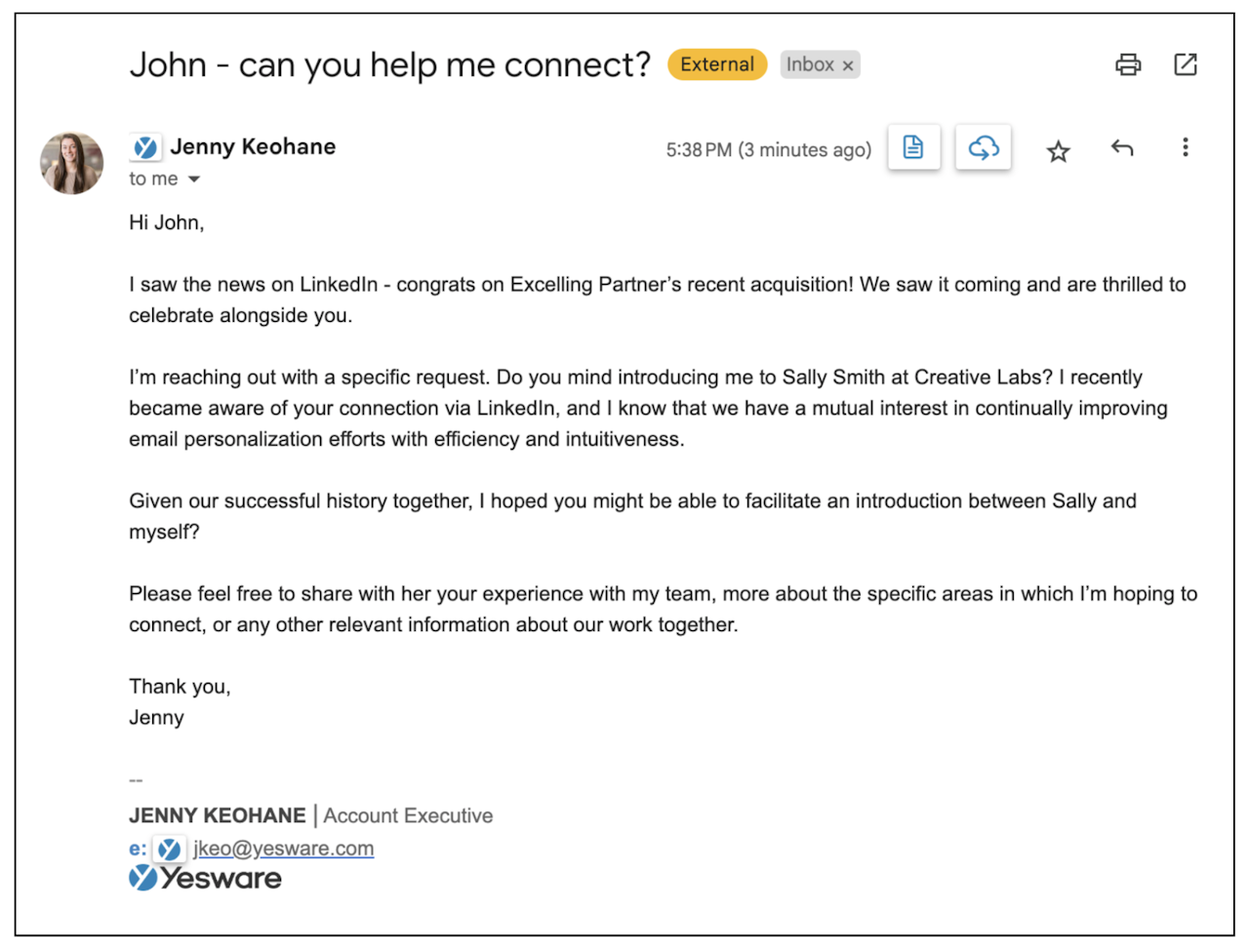
Introduction Email Request Template
And here it is as a template, ready to personalize for your own intros.
Subject Line: {!Name} — can you help me connect?
Hi {!Name},
I trust you’re well. I’m reaching out with a specific request — do you mind introducing me to {!Mutual contact}? I recently became aware of your connection via LinkedIn and know that we have a mutual interest in {!Shared connection/pain point}.
Given our successful history together, I hoped you might be willing to facilitate an introduction between myself and {!Mutual contact}.
Please feel free to share with {!Mutual contact} any relevant information about our work together and the specific areas in which I’m hoping to connect!
Thanks for your help — looking forward to touching base.
Best,
Remember to keep your introduction email simple and to the point. This message isn’t about you or your offer—save your selling points for later.
How to Get an Inside Referral
If you don’t have a mutual connection with the person you’re trying to reach, you may want to try what we call a top-down approach in your introductory email. It goes a little something like this:
- Use LinkedIn to determine who your prospect’s boss is.
- Send a cold email to that Director/VP/CEO level person asking who manages the initiative you’re interested in discussing.
- They (hopefully) point you in the direction of who you want to reach.
- You reference their referral in an email introducing yourself to your prospect.
- Or forward the original email inquiry along with the boss on CC.
Not only does this get you an introduction from someone inside that person’s company, it’s coming from their boss — which makes it much more likely that they’ll reply. That’s because we’re naturally conditioned to follow the lead of authority figures.
Real-world use-case: Here’s a great email introduction sample from Yesware’s CEO that shows what happened when someone (real name changed) asked to connect with a member of our marketing team.
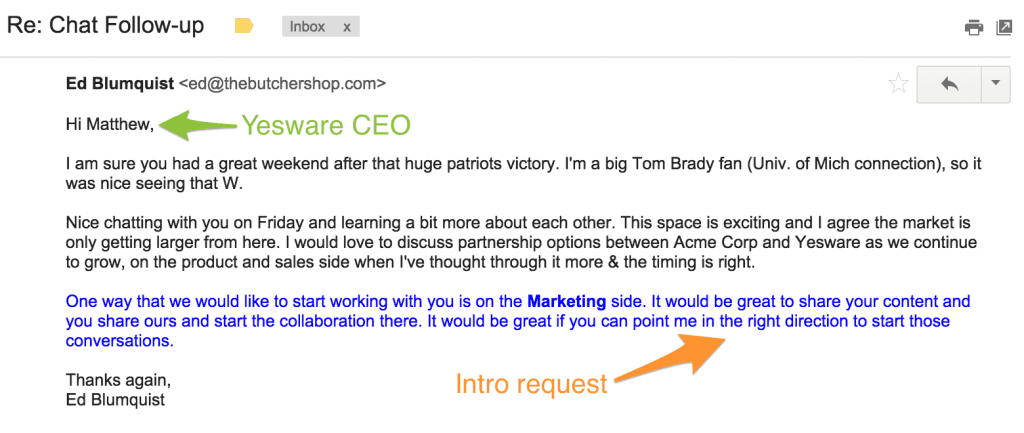
And the response…?

Boom. Intro made. (Although note that we are an email-focused company — other CEOs might not be so responsive 😉).
Referral Introduction Email Template
Here’s the introduction email template:
Subject Line: {!First Name} — Introduction Request
Hi {!First Name},
{!Open with personal connection}.
{!Address any interaction you’ve had with the person}. I would love to discuss partnership options between {!Company} and {!Company} and how {!value of working together}.
One way that we would like to start working with you is {!how you’d like to start working together}. It would be great if you can point me in the right direction to start those conversations.
Thanks,
Looking for more email templates? Here are 18 proven templates for various situations:
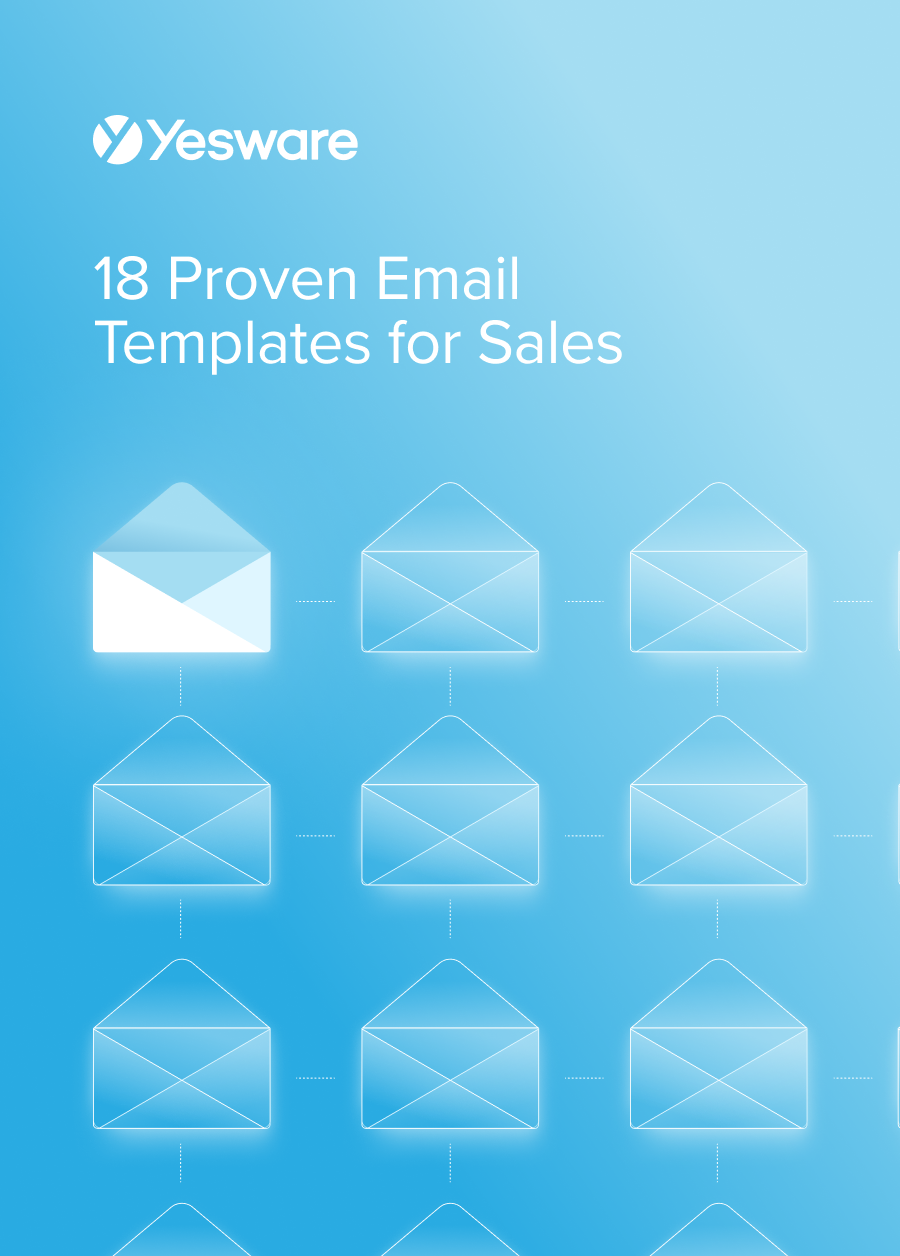 18 Proven Email Templates for SalesWinning email templates for cold outreach, follow-ups, and nurturing relationships – backed by data and real-world examples.
18 Proven Email Templates for SalesWinning email templates for cold outreach, follow-ups, and nurturing relationships – backed by data and real-world examples.
Introduction Email Best Practices
Keep in mind the following best practices as you write introduction emails.
Write an Engaging Subject Line
The subject line is the key to success for the rest of your email.
More than half of recipients decide whether to open your message based on the subject line alone, and an even greater percentage is willing to send you straight to spam without a second thought.
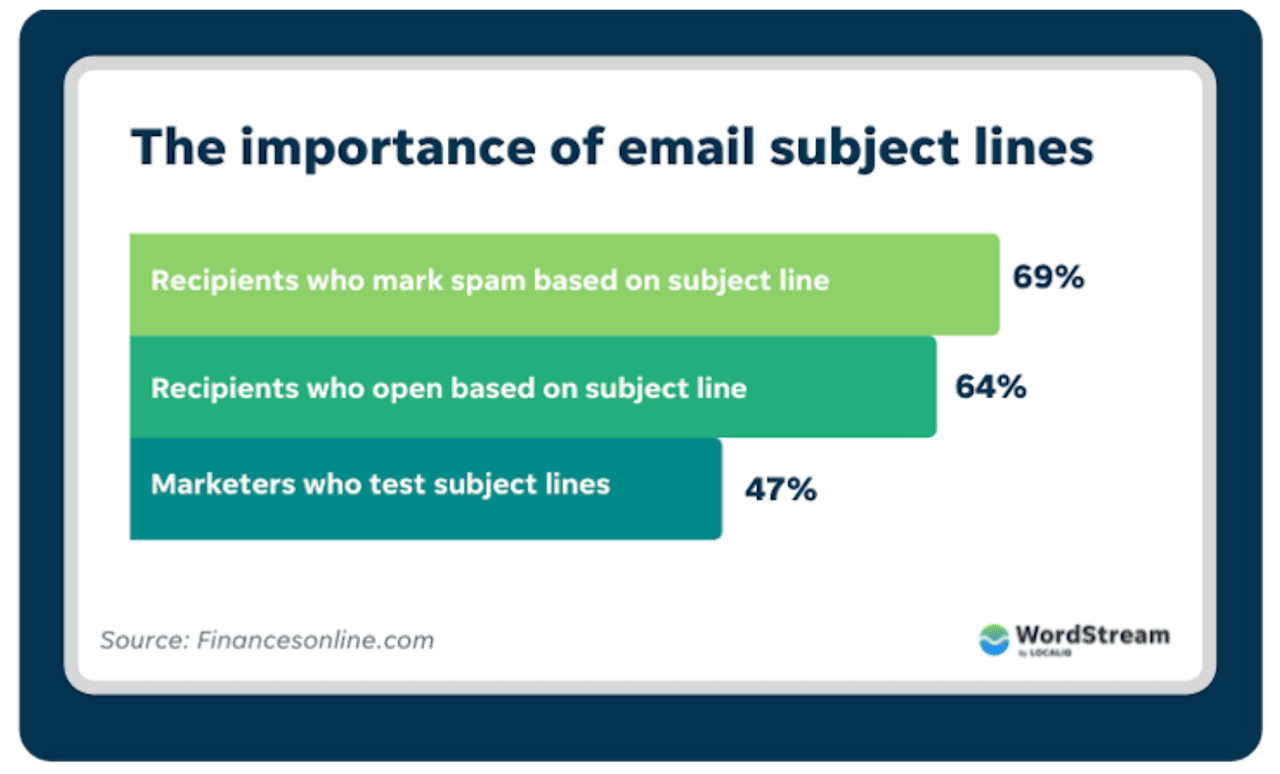
Your email subject line should be short, sweet, and personalized. Do your best to pique the recipient’s curiosity (but don’t mistake this for clickbait!), and try to stick to 50 – 70 characters.
Remember, there’s no need to sell anything in the subject line; the only goal is to get the reader to open your email.
Personalize the Email Opening
After the subject line, the opening line of your email is the next most important factor in determining whether or not your reader will engage with your outreach.
Here are some email opening ideas that help you immediately build rapport with the recipient. 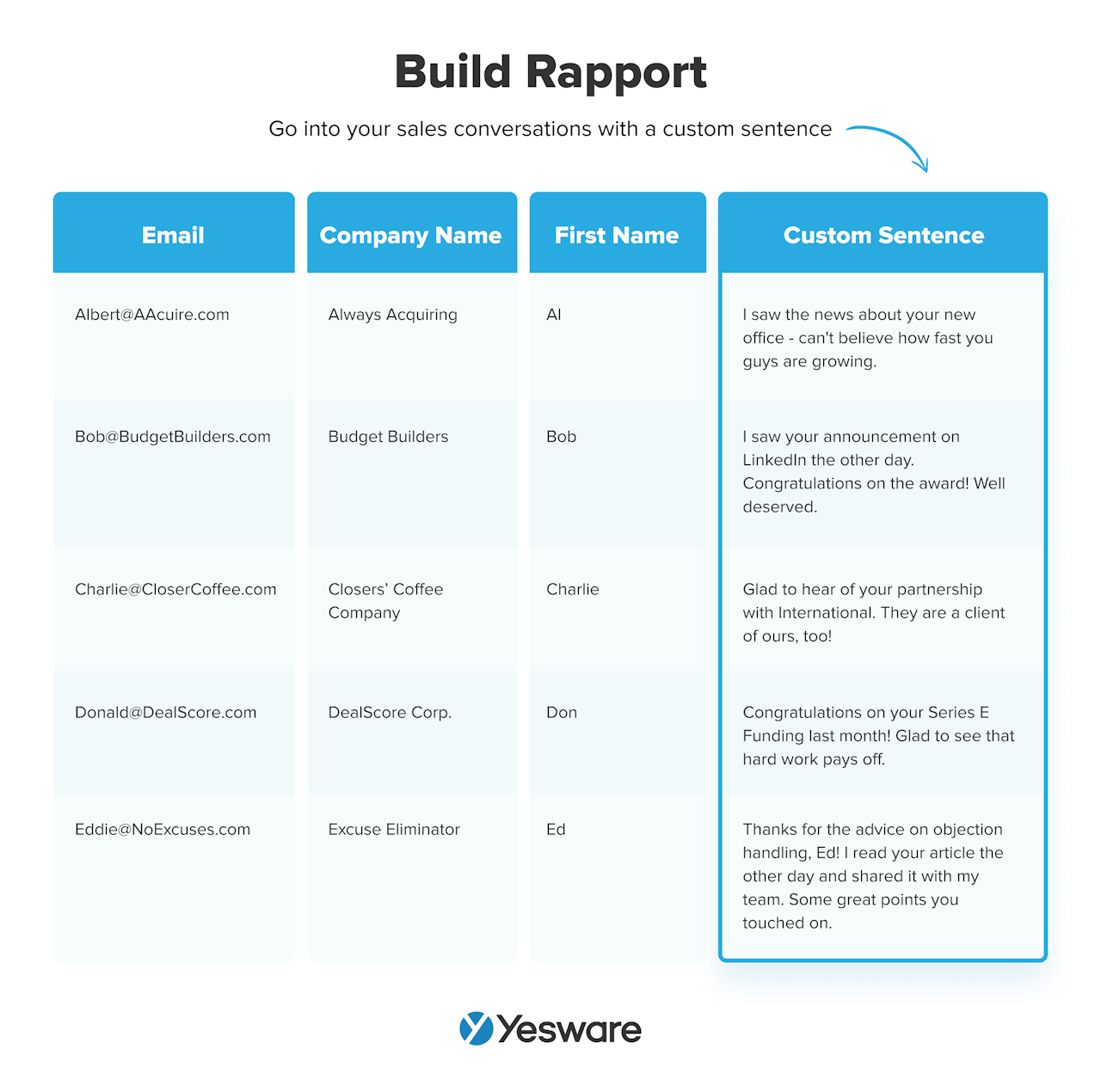 You need to leverage this section of email real estate as efficiently as possible. If you have a mutual contact, it’s smart to mention them in the opening line (LinkedIn can give you a leg up here!).
You need to leverage this section of email real estate as efficiently as possible. If you have a mutual contact, it’s smart to mention them in the opening line (LinkedIn can give you a leg up here!).
The more you can personalize the opening line to the individual recipient, the more likely they’ll be to continue reading.
Make Your Ask Clear
Today’s B2B buyer has no time to waste.
With that in mind, don’t bother beating around the bush in your sales email. Get right to the point, and be clear about why you’re sending them a message.
Do this as succinctly and compellingly as possible. Remember, a sales email—especially one in which you’re requesting an introduction—is not a place for vagueness.
Be confident and clear in your request. Most happy customers are happy to share their success with others who share similar challenges.
Effectively Portray Your Value Proposition
While some of your contacts may be happy to help you make contact with new referrals, others may be more hesitant to put their name on the line without a high degree of confidence. Even your most successful customers may need further convincing that your solution can help others in their network.
Try to convey your value proposition in a way that will relate to your mutual contact. Remember, you don’t need your recipient to commit to anything immediately; all you need is a reply with a positive sentiment. 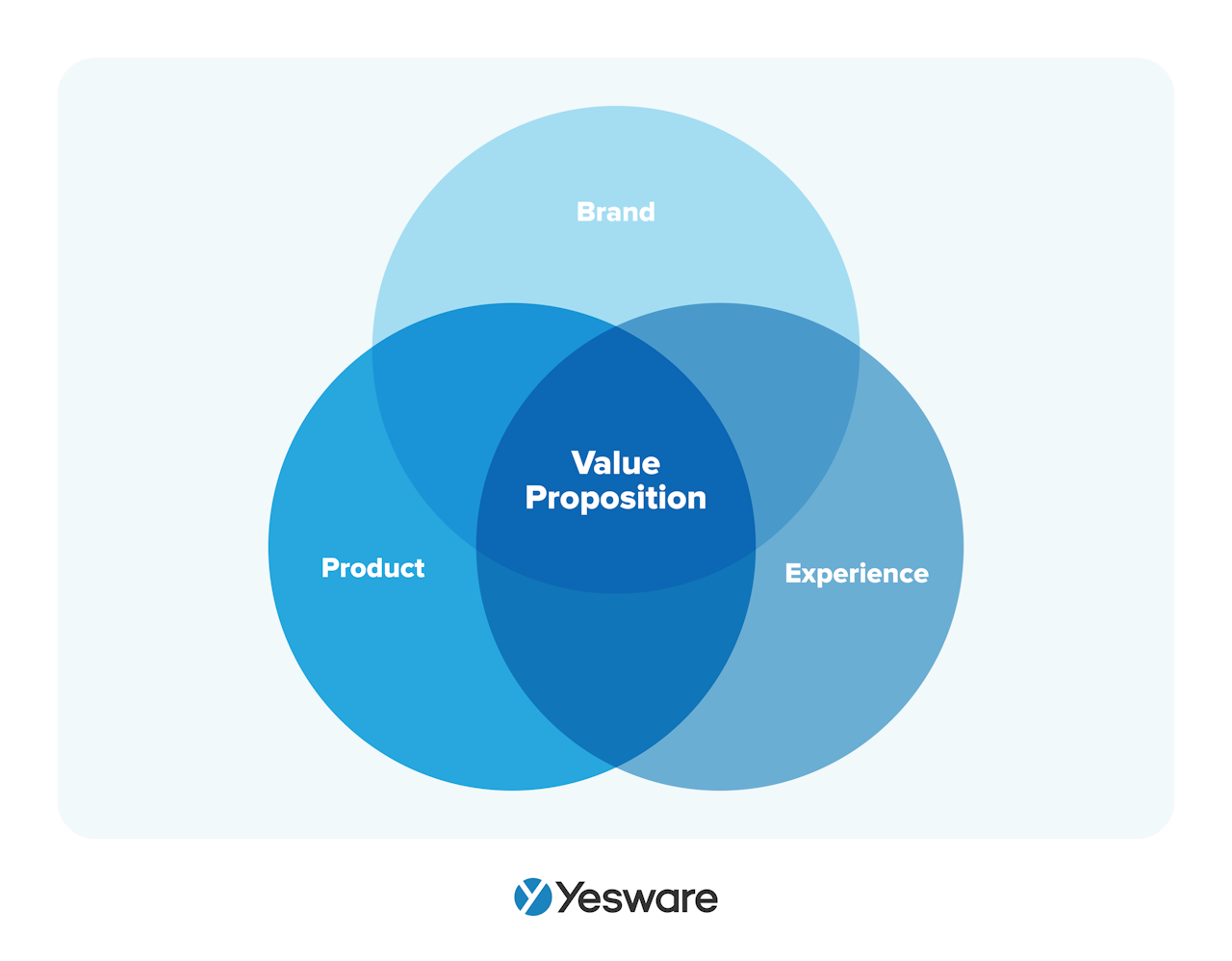
Don’t Forget a CTA
As with all sales emails, introduction emails require a strong call to action (CTA) in order to be effective.
Your CTA should be as brief, clear, and easy to achieve as possible. 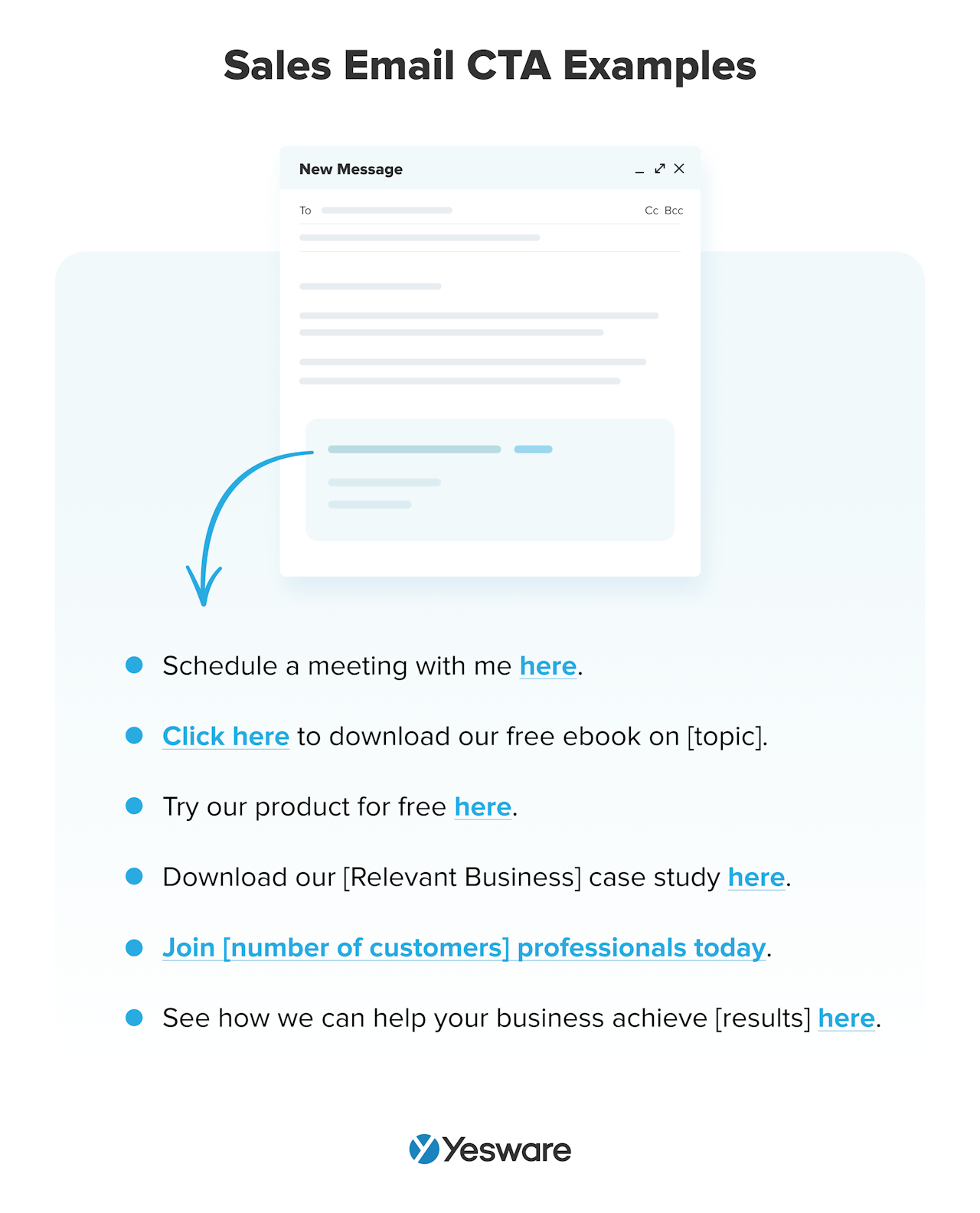 And remember—sales emails are always a marathon, not a sprint. Your CTAs are much more likely to be effective when they encourage the reader to take the next small step, rather than a huge leap.
And remember—sales emails are always a marathon, not a sprint. Your CTAs are much more likely to be effective when they encourage the reader to take the next small step, rather than a huge leap.
Save Your Introduction Emails as Templates
One of the easiest ways to send introduction emails that you know will work is to 1) track their effectiveness and 2) save them as templates so you can easily re-use, personalize, and send them to multiple recipients.
You can do that for free with Yesware.
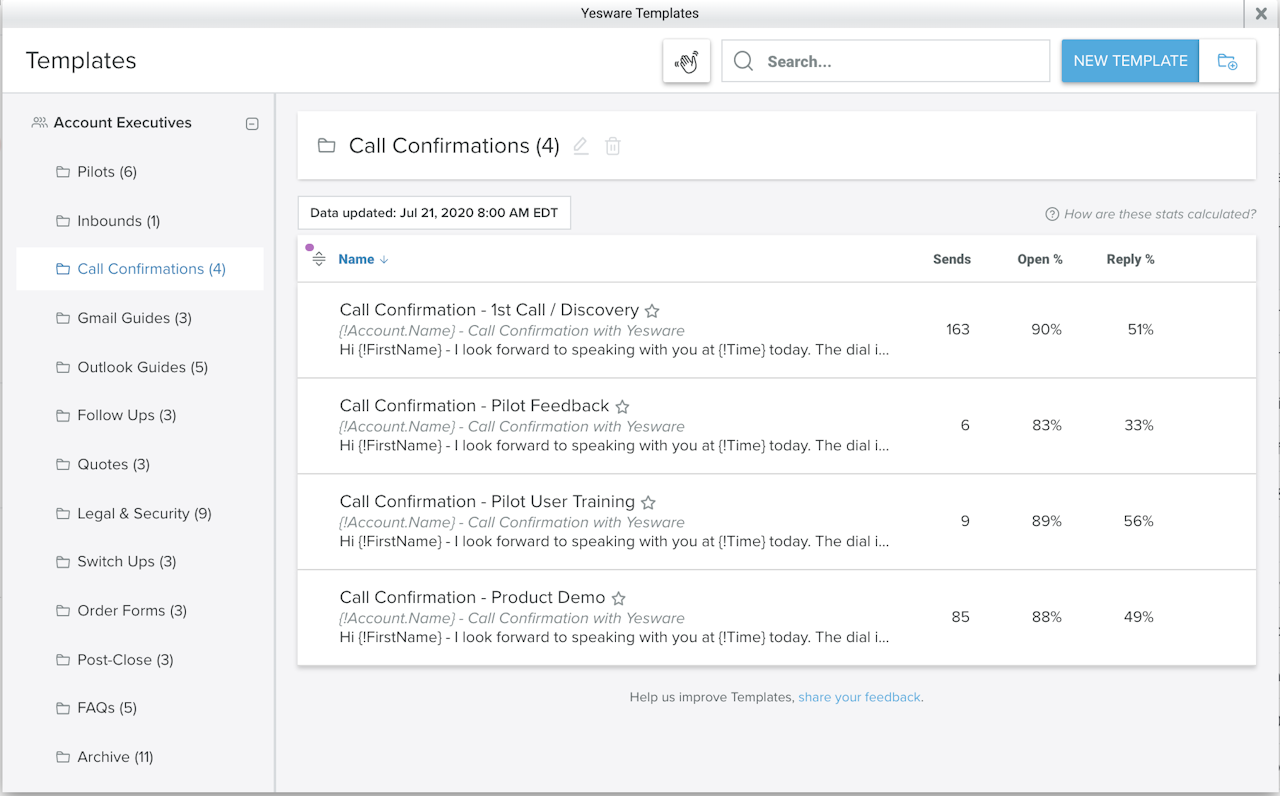
Common Mistakes to Avoid (and What to Do Instead)
Even the best introduction email can fall short if it includes one of these common missteps. Here’s how to spot them—and exactly how to fix them.
1. Generic or Vague Subject Lines
Why it fails: Subject lines that lack clarity or specificity don’t spark curiosity or communicate value. In a crowded inbox, they’re easy to ignore—or worse, mark as spam.
What to do instead:
- Use specific keywords that reference the recipient’s company, pain point, or industry.
- Front-load value with phrases like “Partnership Opportunity” or “Quick Intro Regarding {Topic}.”
- Test personalization by adding their first name, job title, or recent content reference.
2. No Personalization
Why it fails: When an email looks like it was mass-sent or copied and pasted with no thought, recipients feel unimportant and are more likely to delete it.
What to do instead:
- Reference something timely—a recent LinkedIn post, news feature, or company announcement.
- Include specific roles or initiatives that the person is known for or currently leading.
- Mention a mutual connection or shared interest if possible, to build immediate rapport.
3. Too Long or Dense
Why it fails: Long, paragraph-heavy emails make it hard for recipients to quickly understand the point—and many won’t even try.
What to do instead:
- Limit to 3–5 sentences or under 150 words for initial outreach.
- Use formatting like line breaks or bolded CTAs to create visual breathing room.
- Start with value—explain why you’re reaching out in the very first line.
4. Unclear or Weak Ask
Why it fails: If your email doesn’t include a clear, actionable next step, the recipient won’t know what you want—or may be unsure how to help.
What to do instead:
- Make the ask specific and easy to fulfill (e.g., “Can we schedule 15 minutes next week?”).
- Bold or separate the CTA to make it visually distinct.
- Offer context or a one-liner about why you’re making the request.
5. Skipping the Double Opt-In
Why it fails: Introducing two people without getting both of their permission first can feel intrusive or awkward, especially in professional settings.
What to do instead:
- Ask each person privately if they’re open to the connection before making the intro.
- Explain why the intro could be mutually valuable—don’t just ask for a favor.
- Use phrases like “If you’re open to it” or “Happy to defer if now’s not a good time” to show respect.
10 Smart Introduction Email Scenarios
Whether you’re reaching out to a decision-maker, a peer, or a potential mentor, tailoring your introduction email to the scenario increases your chances of a reply. Use the following situations as blueprints for writing powerful, context-aware messages.
1. Introducing Yourself to a Potential Client
- Best for: Prospects in your pipeline or outbound list
- Subject Line Example: Quick intro – helping {Company} with {pain point}
- Opening Line: Hi {First Name}, I’ve been following {Company} and noticed {recent insight}. I work with similar teams on {specific outcome}, and I’d love to see if we can help.
2. Asking a Mutual Connection for a Referral
- Best for: Leveraging warm intros to key accounts
- Subject Line Example: Favor: Would you introduce me to {Name}?
- Opening Line: Hi {First Name}, I saw you’re connected to {Contact Name} at {Company}. I’d love to explore a potential fit and was wondering if you’d feel comfortable making an intro.
3. Introducing Two Colleagues or Contacts
- Best for: Networking, partnerships, vendor relationships
- Subject Line Example: Intro: {Name 1} <> {Name 2}
- Opening Line: Hi both — You’re in similar roles across {industry}, and I think you’d get value from chatting. I’ll let you two take it from here!
4. Welcoming a New Team Member
- Best for: Onboarding internal hires with external stakeholders
- Subject Line Example: Meet {New Hire Name}, your new {Role}
- Opening Line: Hi {Client Name}, I’d love to introduce you to {New Hire Name}, who just joined us as our new {Role}. They’ll be your main point of contact going forward.
5. Reaching Out to a Hiring Manager After Applying
- Best for: Post-application follow-up with context
- Subject Line Example: Interest in {Role} at {Company}
- Opening Line: Hi {Hiring Manager Name}, I recently applied for the {Role} role and wanted to personally express my interest. I’m particularly excited about {specific aspect of the company or job}.
6. Following Up After an Event or Webinar
- Best for: Building on in-person or virtual rapport
- Subject Line Example: Great meeting you at {Event Name}
- Opening Line: Hi {First Name}, I enjoyed our conversation at {Event} about {Topic}. I’d love to continue the discussion and explore how we might collaborate.
7. Introducing Yourself to a New Manager or Executive
- Best for: New reporting lines, internal career transitions
- Subject Line Example: Excited to work with you
- Opening Line: Hi {Manager Name}, I’m looking forward to working with you. I wanted to share a quick intro and some of my current focus areas to hit the ground running.
8. Outreach to an Industry Influencer or Speaker
- Best for: Strategic networking, partnerships, or collaboration
- Subject Line Example: Inspired by your talk at {Event}
- Opening Line: Hi {First Name}, I was really impressed with your session on {Topic}. I’d love to connect and explore how our work intersects.
9. Cold Outreach to a Decision-Maker
- Best for: Breaking into key accounts from scratch
- Subject Line Example: Helping {Company} streamline {initiative}
- Opening Line: Hi {First Name}, I know you’re leading {Initiative} at {Company}. We’ve helped similar orgs cut time-to-close by 30%—mind if I share how?
10. Introducing a New Employee to a Client or Stakeholder
- Best for: Transferring relationships or introducing account contacts
- Subject Line Example: Meet your new point of contact
- Opening Line: Hi {Client Name}, I’d like to introduce you to {New Team Member}, who will be taking over as your main contact. They bring {experience or value}, and I know you’re in great hands.
Looking for more tips on introduction emails? See our guides below:
This guide was updated on May 2nd, 2025.
Get sales tips and strategies delivered straight to your inbox.
Yesware will help you generate more sales right from your inbox. Try our Outlook add-on or Gmail Chrome extension for free, forever!
Related Articles
Jenny Keohane
Jenny Keohane
Melissa Williams
Sales, deal management, and communication tips for your inbox

